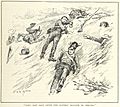Battle of Nalapani facts for kids
Quick facts for kids Battle of Nalapani |
|||||||
|---|---|---|---|---|---|---|---|
| Part of the Anglo-Nepalese War | |||||||
|
|||||||
| Belligerents | |||||||
| Commanders and leaders | |||||||
| Major-General Rollo Gillespie † Colonel Sebright Mawbey |
Captain Balbhadra Kunwar | ||||||
| Strength | |||||||
| 3,513 men initially | about 600 (men, women and children) | ||||||
| Casualties and losses | |||||||
| over 69 dead 671 wounded |
over 90 dead 440 wounded |
||||||
The Battle of Nalapani was the very first fight in a big war called the Anglo-Nepalese War. This war happened between 1814 and 1816. It was fought between the British East India Company and the Kingdom of Nepal. Nepal was ruled by the Gorkha family at that time. The battle took place around a fort called Nalapani, near a town called Dehradun.
Contents
What Was the Battle of Nalapani?
The British army surrounded the Nalapani fort. This is called a siege. The siege lasted from October 31 to November 30, 1814. Captain Balbhadra Kunwar led the soldiers inside the fort. They were called the garrison.
The British attacking force was led by Major-General Rollo Gillespie. He had fought in other battles before, like the Battle of Java. Sadly, Gillespie was killed on the first day of the siege. He was trying to encourage his soldiers.
A Brave Stand at Nalapani Fort
The Nepalese soldiers, led by Balbhadra, were greatly outnumbered. There were about 600 people in the fort, including men, women, and children. The British had more than 5,000 soldiers. The British also had much stronger weapons.
Despite these challenges, Balbhadra and his small group held out for over a month. They bravely defended the fort.
How the British Won
The British tried to attack the fort directly two times. Both attacks failed and cost them many soldiers. So, they changed their plan. They decided to cut off the fort's water supply. This would force the people inside to surrender.
After three days without water, the people in the fort were very thirsty. On the last day of the siege, Balbhadra was asked to give up. But he refused to surrender. Instead, he led the 70 surviving members of his group in a daring charge. They fought their way out of the fort. They escaped into the nearby hills.
What Was the Result?
The British finally captured the fort. But it took them a lot of time, effort, and soldiers to do it. This kind of victory is called a pyrrhic victory. It means you win, but the cost is so high that it feels like a loss.
Other battles in the war, like the one at Jaithak, also happened in a similar way. The fighting at Nalapani showed everyone how brave the Gurkha soldiers were. Because of their courage, the British later started recruiting Gurkhas to join their own army.
Images for kids




